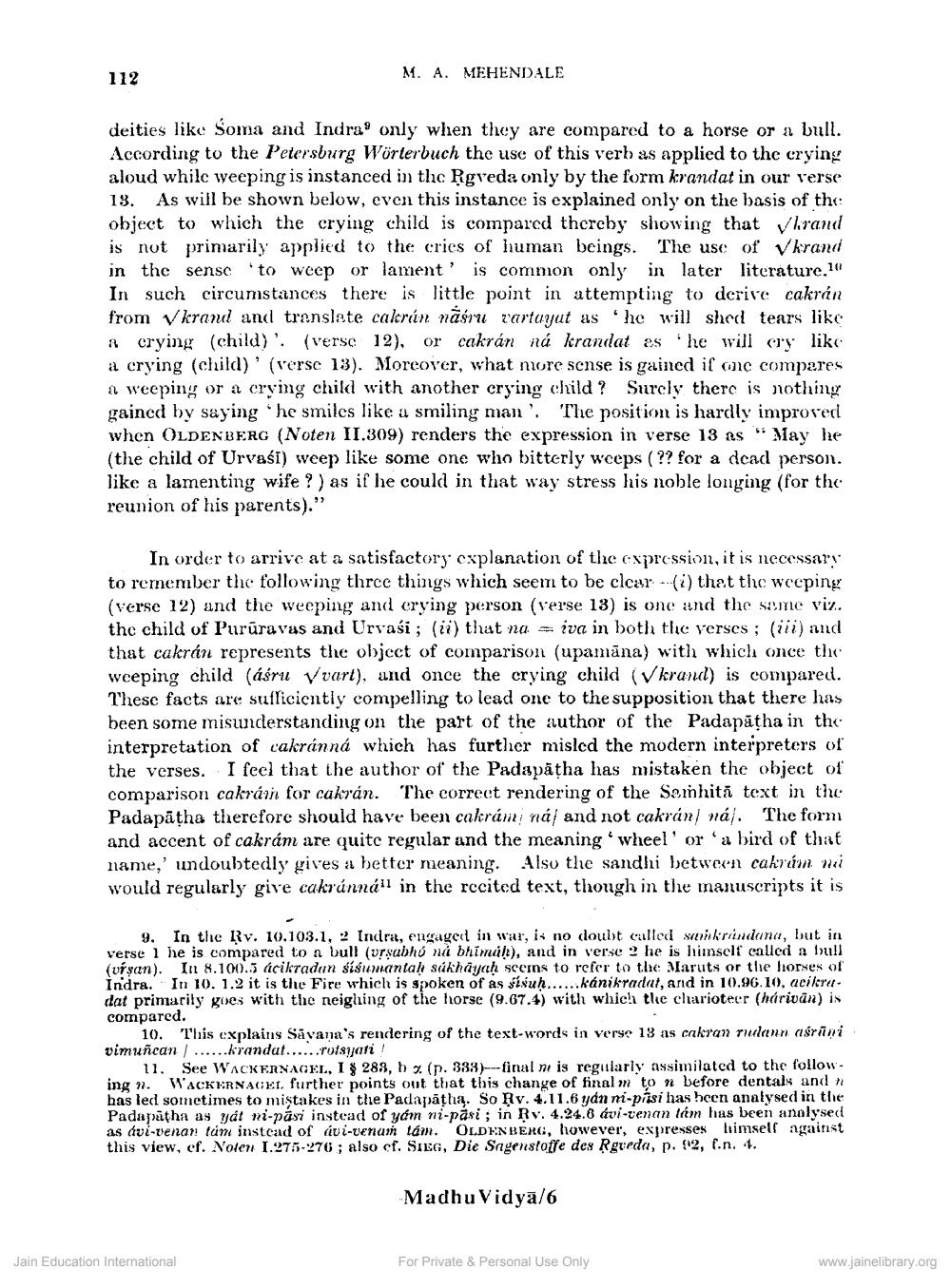________________
112
M.A. MEHENDALE
deities like Soma and Indra® only when they are compared to a horse or a bull. According to the Petersburg Wörterbuch the use of this verb as applied to the crying aloud while weeping is instanced in the Rigveda only by the form krandat in our verse 13. As will be shown below, even this instance is explained only on the basis of the object to which the crying child is compared thereby showing that rand is not primarily applied to the cries of human beings. The use of V krandi in the sense to weep or lament' is common only in later literature 10 In such circumstances there is little point in attempting to derive cakrán from V krand and translate calerón nåśru vartayut as 'He will shed tears like & crying (child)'. (verse 12), or cakrán ná krandat as he will cry like a crying (child) (verse 13). Moreover, what more sense is gained if one compares a weeping or a crying child with another crying child ? Surely there is nothing gained by saying he smiles like a smiling man'. 'The position is hardly improved when OLDENBERG (Noten II.309) renders the expression in verse 13 as " May be (the child of Urvasi) weep like some one who bitterly wceps (?? for a dead person. like a lamenting wife ? ) as if he could in that way stress his noble longing (for the reunion of his parents)."
In order to arrive at a satisfactory explanation of the expression, it is necessary to remember the following three things which seem to be clear (i) that the weeping (verse 12) and the weeping and crying person (verse 13) is one and the seme viz. the child of Purūra vas and Urvasi; (ii) that na = iva in both the verses ; (ii) and that cakrán represents the object of comparison (upamāna) with which once the weeping child (áśru Vvart), and once the crying child (V krand) is compared. These facts are sufficiently compelling to lead one to the supposition that there has been some misunderstanding on the part of the author of the Padapātha in the interpretation of cakránná which has further misled the modern interpreters of the verses. I feel that the author of the Padapātha has mistaken the object of comparison cakrárn for cakrán. The correct rendering of the Samhita text in the Padapātha therefore should have been cakrám ná/ and not cakran) wá). The form and accent of cakram are quite regular and the meaning 'wheel' or 'a bird of that name,' undoubtedly gives a better meaning. Also the sandhi between cakrám ni would regularly give cakránnáll in the recited text, though in the manuscripts it is
9. In the Rv. 10.103.1, Indra, engaged in war, is no doubt called suurkrindana, but in verse 1 he is compared to a bull (ursabho ni bhimil), and in verse ? he is himself called a bull (vísan). In 8.100.5 aciktadun sisuwantah sukhāyah seerns to refer to the Maruts or the horses of Indra. In 10. 1.2 it is the Fire which is spoken of as fisuh...... kánikradat, and in 10.96.10, aciera. dat primarily goes with the neighing of the horse (9.67.4) with which the charioteer (hårivün) is compared.
10. This explains Savana's rendering of the text-words in vers. 13 as cakran tuulann asrini vimuñcan / ......krandat......rotsijati!
11. See WACKERNAGEL, I % 283, b (. 333)---final ni is regularly assimilated to the following n. WACKERNACEL further points out that this change of final m ton before dentals and n has led sometimes to mistakes in the Padapatha. So Ķv. 4.11.6 yan ni-pisi has been analysed in the Padapatha ay yát ni-pási instead of yám ni-päsi; in Rv. 4.24.6 ávi-venan tám has been anolysed as avi-venan tüm instead of civi-uenan tám. OLDENBERG, however, expresses himself against this view, cf. Noten 1.275-276; also cf. SIEG, Die Sagenstoffe des Rgueda, p. 2, f.n. 1.
Madhu Vidyā/6
Jain Education International
For Private & Personal Use Only
www.jainelibrary.org




